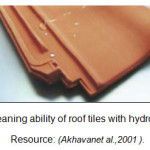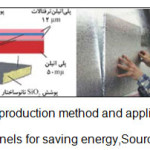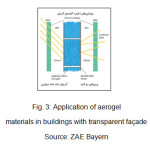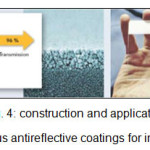Study of Nanotechnology Application in Construction Industry (Case Study: Houses in North of Iran).
Fariborz Haji Seyed Javad1 * , Raziyeh Zeynali2 , Farzaneh Shahsavari2 and Zahra Motevali Alamouti2
1
School of Architecture and Urbanism,
Imam Khomeini International University (IKIU),
Qazvin,
Iran
2
Imam Khomeini International University (IKIU),
Qazvin,
Iran
Corresponding author Email: fajavadi@yahoo.com
DOI: http://dx.doi.org/10.12944/CWE.10.Special-Issue1.134
Increasing demands for using new, high quality and more efficient materials in construction industry, meanwhile using less raw materials and energy has resulted in application of new modern technologies in this industry. One of the greatest modern technologies of current century is nanotechnology which can be useful in eliminating the needs of construction industry. The purpose of this paper is to study procedure and advantages of using this technology in construction industry, specifically in houses in north of Iran. Accordingly, documentary study method is used to reach the aforementioned purpose and research method is descriptive-analytical. The results show that despite the high cost of nanomaterial, using nanotechnology in construction industry could cut a lot in direct material expenses and eventually, these expenses return to the building.
Copy the following to cite this article:
Javad F. H. S, Zeynali R, Shahsavari F, Alamouti Z. M. Study of Nanotechnology Application in Construction Industry (Case Study: Houses in North of Iran). Special Issue of Curr World Environ 2015;10(Special Issue May 2015). DOI:http://dx.doi.org/10.12944/CWE.10.Special-Issue1.134
Copy the following to cite this URL:
Javad F. H. S, Zeynali R, Shahsavari F, Alamouti Z. M. Study of Nanotechnology Application in Construction Industry (Case Study: Houses in North of Iran). Special Issue of Curr World Environ 2015;10(Special Issue May 2015). Available from: http://www.cwejournal.org?p=788/
Download article (pdf)
Citation Manager
Publish History
Select type of program for download
| Endnote EndNote format (Mac & Win) | |
| Reference Manager Ris format (Win only) | |
| Procite Ris format (Win only) | |
| Medlars Format | |
| RefWorks Format RefWorks format (Mac & Win) | |
| BibTex Format BibTex format (Mac & Win) |
Article Publishing History
| Received: | 2014-11-15 |
|---|---|
| Accepted: | 2015-12-30 |
Introduction
Improvements in technologies and also mankind's need for different structures has resulted in extensive research in attributes and behavior of materials that in return, results in introducing different types of structures and application of deferent materials (Ahmadi Moghadam et al.,2011 ).
Nanotechnology as a key inter-disciplinary technology has created many opportunities in order to fortify the competition in construction industry like building faster, flexible, more desirable, more stable and more efficient; and application area for this technology applies to almost all parts of building, including structure, exterior design, engineering (building systems) and interior design. Nanotechnology is also referred to as the renaissance of technologies. Arrival of products related to this technology would lead to a great leap in quality of life and environmental efficiency. Construction industry has great expenses that besides construction costs, includes maintenance costs, too. By relying on nanotechnology, besides increasing useful life of buildings, we can also manage the amount of energy consumption; the amount of materials used and their strength and application would extensively increase; and their variety and accordingly, their efficiency level would increase.
Because in northern regions of Iran, with its mild and humid climate, rainfall rate in most seasons of the year is extremely high, it makes multiple problems for construction industry of these regions, especially for houses. the application of nanotechnology is studied as the case study for this research because of its properties and as an efficient solution for houses in north of Iran; results show that by using nanotechnology in construction industry, energy and quality of life expenses drop extensively and most of design restrictions in these regions would be eliminated.
Research objectives and procedure
The purpose of this paper is to study the procedure of using nanotechnology in construction industry and its advantages, especially in houses of northern regions of Iran. Research method in this paper is based on documentary studies and it is done by field research and descriptive-analytical study.
In studies section, after a review of the concepts of nano and nanotechnology, application of nanotechnology in construction industry has been studied.
Theoretical foundations
Concept of nano
Still there is no internationally clear definition for nano technology but the definition they all agree with is to analyze and research study materials in nano scale. Accordingly, each and every research activities performed in scales under 100 nanometer is considered as nanotechnology (Glolabchi et al., 2011). Lexical definition of nano is one in a billion and it is derived from Greek word "nanos" which means midget (Moayed et al., 2009).
Concept of nanotechnology
In the following compound "nanotechnology", nano refers to the scale of nanometer (nm) which is equal to one in a billion in a meter (Moayed et al., 2009).In construction section, nanotechnology can be referred to as a kind of "empowering technology" that lets mankind envision new fields of development and progress before his eyes by using such an interesting technology (Glolabchi et al., 2011). Nanotechnology is a noun that refers to some kind of production technology and is achieved when there is the ability to build up things from atoms and if so, there is the ability to reshape materials accuracy.
Nanotechnology and buildings
So far, most of the convincing topics related to the application of nanotechnology in architecture and construction industry have been about energy efficiency. Nanotechnology is a technological instrument that can cope with climate changes and help reduce the greenhouse gases emitted by fossil fuels. Application of nanotechnology in construction industry is deeply related to sustainability issue (Leydecker et al., 2008).
Nano-architecture is a new architectural style of the 21st century that will revolutionize architecture in every aspect, nano applications in architecture can make changes in most apects like changing architect's vision, design techniques and ideas, construction methods, structure technologies, statics, form and aesthetics of framework, mechanical systems, lighting, topic of energy, maintenance and repair techniques, decoration and interior design, etc.
Generally, areas of construction industry in which nanotechnology might be able to pave the way for future evolutions can be abstracted to the following:
- Producing strong, intelligent materials besides repairing and renovating current structures;
- Modern and innovative system that can optimize the chain of "designing-production-utilization-demolition" in construction facilities. It is done by developing new tools and equipment based on information technology;
- New technology for processing multi-cultural products/works;
- New material production methods that effectively influence on decreasing water and energy consumption, in addition to producing much less waste products. Besides that, developing production methods based on environmental sustainability that can recycle construction products is also related to nanotechnology (Glolabchi et al., 2011).
Table 1: Application Area of Nanotechnology for Quality Improvements in Buildings Resource: (Glolabchi et al., 2011).
|
Materials |
Nanomaterial |
Prospects |
|
|
1 |
Concrete |
Carbon nanotubes SiO2 Fe2O3 |
Sufficient reinforcement Fraction prevention |
|
2 |
Steel |
Copper nanoparticles |
Improve weld quality Improve oxidation resistance |
|
3 |
Windows |
TiO2 SiO2 |
Self-cleaning ability Anti-fogging Prevent heat and ultraviolet infiltration Resistance against fire |
|
4 |
Tints/coating |
TiO2 Silver nanoparticles |
Anti-dirt Bacteria and bug killing ability |
|
5 |
Solar cells |
Cover shade / TiO2 Carbon nanotubes & C60 CdSe quantum dots |
More efficient application of solar energy |
|
6 |
Cement |
Carbon nanotubes Polypropylene nanofiber |
Improve strength Resistance against fire |
|
7 |
Sensors |
Carbon nanotubes |
On time structure safety evaluation |
Case study and research findings
In this section, in order to explain the subject, houses in northern regions of Iran are chosen as the case study. Some of the climate characteristics of these regions are high rainfall rate in all seasons of the year (especially autumn and winter) and almost high humidity level in all seasons (Ghorji mahlabani et al., 2009). These features may in some cases cause multiple problems such as water infiltration into the building, making fog, etc. accordingly, the following content is dedicated to study the application of nanotechnology in different parts of these houses and its advantages.
Nanotechnology application in façade and rooftops of houses in northern regions of Iran
Nanotechnology offers multiple solutions to improve exterior surfaces of a building in terms of aesthetics and performance. Using nanomaterial, surface properties can be preferably modified against water and dust with verity of characteristics such as hydrophilic surfaces, hydrophobic surfaces or oleo phobic surfaces. At the times of moister infiltration hydrophobic surfaces turn this moister into a thin layer of water flow and by preventing water drops formation, prevent making fog and mist on windows and mirrors (Hoseini et al., 2012).
 |
|
Residential and commercial sectors with average growth of 7.5% compared to the last decade, accounting for 39% of total energy consumption in this country, are considered to be the largest consumers of energy. Therefore, among the available instructions regarding energy consumption pattern correction, incorporating thermal insulator to the building shell is of great importance.
Nano insulation materials with 39 times more insulation ability compared to glass wool are among modern insulation materials. These materials can be easily applied on walls using hand brush, roller brush or air brush. Nano insulation material is a new products of nanotechnology that is considered a sufficient thermal protection and insulation for all three modes of heat transfer including radiation, advection and convection. With such characteristics, these insulation materials can be applied to buildings without any appearance change in building composition. Less thickness, moisture and fungus resistance, water and soap washability, colorability, fire resistance and anti-oxidation are some advantages of these materials (Baradarzadeh et al., 2008).
Application of thermal insulators in façade of houses in northern regions is imperative in building economy not only in terms of investment costs for construction or renovation, but also in terms of operation costs.
 |
|
Aerogel materials can also be used for transparent façades or roof windows thanks to their light-transferability. These types of aerogel windows are double paned and the space between panes is filled with granular aerogel.
Aerogels are good light transmitters, change direct light into scattered light, eliminate the need for curtains, on cloudy days interior environment happens to be brighter than the outside and because of their hydrophobic character, moisture and fungus would no longer be problematic for these houses (Leydecker et al., 2008).
 |
|
Strong covers for protecting wood against atmospheric parameters
Nano-based wood protective coating that is sold under Lingol brand name is a type of multi-purpose suffusing water-based cover that is used to protect wood against atmospheric parameters (especially on naked surfaces and exterior areas of buildings). This coating has great hydrophobic character that prevents water infiltration and adverse effects of rainfall on the wood. Besides that, offers great protection against ultraviolet rays and prevents darkening of surface.
This coating, although being hydrophobic, have ventilation and low vapor permeability so it is the best way of controlling moisture content of wood and by using that, maximum protection of wooden part is insured (Glolabchi et al., 2011).
Besides ordinary construction uses, Lingol coating is suitable for beach houses, humid regions and water crafts such as boats and ships, too (Glolabchi et al., 2011).
Ultraviolet rays are among factors that cause decay and destroy construction materials. So nanotechnology offers the possibility of making ultraviolet resistant and anti-decay coating for wooden materials (Glolabchi et al., 2011).
It is clear that the solution this technology envisions for preventing decay and moss growth on wood not only does not contradict with environmental sustainability purposes and is not a threat to ecosystem and environment, but immensely diminishes moisture absorption of wood which is one of the most important problems of the houses in northern regions.
Nanotechnology application in windows
Glass, because of its transparency and high resistance in any form and color, is globally known as the construction material for windows and façade. But immediate dirt absorption, especially in houses in north of Iran, undesirable reflections and bad performance as thermal insulator are considered as weak points for glass. Nono covers considerably eliminate these weak points and by that, create new application areas for glass façades. For example:
• Improve thermal protection using energy saving covers (Low-E)• Solar protection (anti-UV) using colorchanging glass (Electrochromic glass)
• Self-cleaning ability using photocatalytic coating
• Antireflective coatings using SiO2 layer with nanohole arrays
• Antireflective coatings for reinforced glasses with more light transmission ability that, for instance, are used on solar collectors and building windows are considered as impressive improvements of nanotechnology (Baradarzadeh et al., 2008).
Antireflective coatings for reinforced glasses with more light transmission ability that, for instance, are used on solar collectors and building windows are considered as impressive improvements of nanotechnology (Baradarzadeh et al., 2008).
 |
|
Transmission in plate glass Energy saving glasses, besides having variety of colors and other properties, can prevent energy loss by up to 85% in summer and 80% in winter regarding the ability to drastically diminish the transition of ultraviolet and infrared rays and control visible light transition level. Energy saving glasses are made by applying multiple layers of metal and metal oxide/nitride on glass surface in controlled thicknesses. This nanocomposite fiber is almost 3-5 micron thick with a formulation relevant to the glass (nanotechnology magazine, issue 150). These glasses, although being colorless and transparent, have extraordinary properties regarding energy and sunlight control level. In fact, these glasses do a good job of visible sunlight transition, with no change in color and by that, result in lower energy consumption by lamps. They also reflect a large percentage of infrared radiation and almost eliminate all the infrared radiation with wave length of 3000 nanometer; so heat transition through windows is prevented. This function prevents sunlight and exterior heat entering inside in summer and reduces the need for cooling devices.
It also acts as thermal insulator in winter, absorbing heat radiated to the windows inside and preventing heat extraction from inside, therefore minimizing the need for heating devices(Hoseini et al., 2012).
Using nanotechnology in cleaning surfaces
Easy-to-clean surfaces are surfaces that are water-repulsive. These surfaces have less energy compared to absorbent surfaces that results in reduction of surface energy and grip. This characteristic can be used in building services and laundry rooms. Because of this characteristic, this type of surfaces are easily and effortlessly cleaned which leads to efficiency in terms of time and expenses (Leydecker et al., 2008).
Nanotechnology application in creating anti-fog coating
Northern regions of Iran are usually covered with fog because of its mild and humid climate; using this characteristic of nano, surfaces can become neutral against fog and this advantage makes creating architects' visions of architectural designs possible.
Anti-fog coatings are made of alternating layers of polymer and silica nanoparticles with hydroxyl groups attached to them and can be used on glass and other materials. This coating is very rough in nano scale but hydroxyl helps nanoholes placed in different layers absorb water like a sponge and immediately remove that off the surface (Mosayebi Jirandeh., 2008).
Nanotechnology application in improving efficiency
So far, improving energy efficiency of buildings has been the largest area that has challenged engineers to use nanomaterial in designing and engineering buildings. Nanotechnology gives us a modern technical tool that can cope with climate changes and helps us reduce the emission of greenhouse gasses in future. Application of nanomaterial is deeply related to [environmental] sustainability of building(Glolabchi et al., 2011).
Nanotechnology offers numerous options to improve productivity and develop new energy production methods and lighting techniques in buildings, for instance:
- Light emitting diodes (LEDs) as a lighting technique with high energy efficiency for specific uses in building (façade lighting, guiding lights and color lights)
- Color solar cells with transparency and aesthetic (decorative) characteristics, like in glass façades as a replacement for silicon-based solar cells
- Core/shell nanostructures and catalyzers for more efficient fuel cells in electricity and heat section suing natural gas.
Regarding low energy consumption, beautiful colors and extremely small dimensions of LEDs (which is based on semiconductor coatings in nano scale), architects are able to show off their talent in lighting and exterior design of buildings.
Results
Because construction industry has great expenses regarding construction and maintenance costs, by relying on nanotechnology, besides increasing useful life of buildings, we can also manage the amount of energy consumption in a way that we could move towards sustainability and by improving the quality of life, pave the way for next generations. Houses in northern regions of Iran in some cases are exposed to severe climate conditions and demand spending money, manpower and time so that they can offer comfort. Application of nanotechnology in different parts of these houses, including exterior façade and openings, roof, etc. could help reduce the amount of utilized material and energy, eliminate moisture and its problems, prevent fogging conditions, etc. And eventually, all the expenses spent on nanomaterial would return to the building. In order to achieve this goal and application of this technology in construction industry, we need to prepare required conditions and equipment, persuade educational centers and apply essential experiences of this field.
References
- Ahmadi Moghadam, H. Kamranzadeh Foomani, M. Tafaroj Fakour, T. lightweight nano concrete, Fan-o-Honar magazine, Guilan construction engineering organization, issue 52, pp. 8-13. (in Persian) (2011).
- Akhavan, A. and others, nanotechnology, mirror to the creation, nanotechnology researchers Co., Tehran, nanotechnology initiative council. (in Persian) (2001).
- Baradarzadeh, M. and others, Nanotechnology, 1st Edition, Tehran, Nano student-club. (in Persian) (2008).
- Ghorji mahlabani, Y. Daneshvar, K. Climate and its impact on shaping traditional architectural elements of Ghilan, Arman Shahr magazine, issue 4, spring & summer, 135-145 (2009).
- Glolabchi, M. Taghizadeh, K. Soroushnia, E. nanotechnology in architecture and construction engineering, Tehran, Tehran University Publication. (in Persian) (2011).
- Hoseini, F. S. Mohammadi Yazdi, S. Nanotechnology application in construction industry (of Germany), nanotechnology observation reports, science & technology department, nanotechnology initiative council. (in Persian) (2012).
- Leydecker, S. Kölbel, M. Peters, S, Nano materials in architecture, interior architecture and design, 1st edition, Berlin, part of springer science+ business media (2008).
- Leydecker, S. Kölbel, M. Peters, S. Nano materials in architecture, interior architecture and design, 1st edition, Berlin, part of springer science+ business media (2008).
- Moayed, F. Eslamipour, F. Moradi, M .A. New world, Nano world, 3rd Edition, Nano student-club, Atena publication. (in Persian) . (2009).
- Mosayebi Jirandeh, A. Promoting nanotechnology. (in Persian) (2008).






